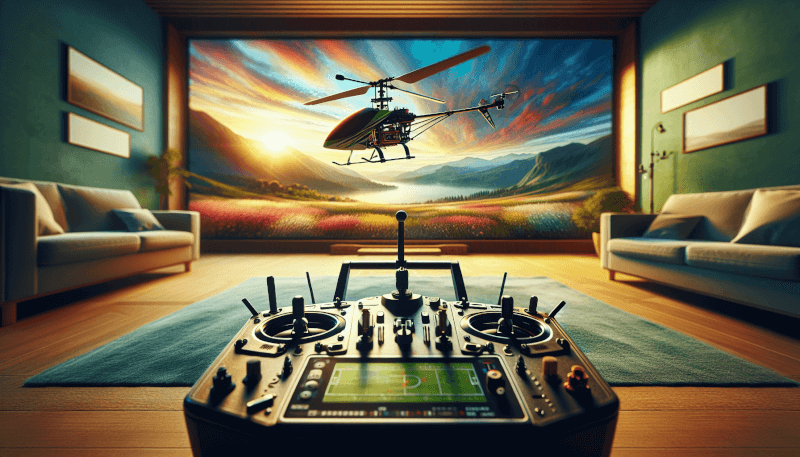So, you’ve recently taken up a new hobby – flying remote control helicopters. It’s a thrilling experience, feeling the wind rush past as you navigate the skies. But now, you’re ready to take it to the next level. You’ve heard about First-Person View (FPV) flying – the ability to see what your helicopter sees through a live video feed. Sounds exciting, right? Well, in this article, we’ll walk you through the process of setting up your RC heli for FPV flying, so you can fully immerse yourself in the thrilling world of aerial adventure. Get ready to soar to new heights!

Choosing the Right RC Heli
Whether you are a beginner or an experienced pilot, choosing the right RC heli is essential for a successful and enjoyable FPV flying experience. Consider your skill level when selecting a heli. If you are new to RC flying, it is advisable to start with a beginner-friendly model. These helis are usually smaller in size and easier to control, allowing you to gradually develop your piloting skills.
In addition to your skill level, you should also determine the size and type of heli that best suits your needs. Smaller helis are more maneuverable and better suited for indoor flying, while larger helis offer greater stability and are ideal for outdoor flights. Consider whether you prefer a fixed-pitch or collective-pitch heli. Fixed-pitch helis are easier to control but provide less flexibility, whereas collective-pitch helis offer more agility and aerobatic capabilities.
Researching the available options is crucial before making a purchase. Look for helis that are specifically designed for FPV flying, as they often come with built-in features and compatibility for FPV systems. Reading reviews and seeking recommendations from fellow RC enthusiasts can also provide valuable insights into the performance and reliability of different heli models.
Selecting the FPV System
Understanding the components of an FPV system is the first step in selecting the right one for your RC heli. The main components include a camera, video transmitter, receiver, and display. Each component plays a vital role in transmitting the live video feed from your heli to your goggles or monitor.
When choosing a camera, consider factors such as image quality, field of view, and low-light performance. A high-resolution camera with a wide field of view will give you a more immersive FPV experience. Additionally, opt for a camera with good low-light performance, as this will allow you to fly in different lighting conditions.
Decide on a video transmitter that is compatible with your heli and offers a suitable transmission range. Higher transmitter power typically results in a longer range but also consumes more battery power. Strike a balance between range and power consumption based on your flying preferences.
Selecting a reliable receiver and display is essential for receiving and viewing the video feed from your heli. Choose a receiver that matches the frequency and channels of your video transmitter. For the display, consider factors such as screen size, resolution, and compatibility with your goggles or monitor.
Installing the FPV System
Properly installing the FPV system is crucial for optimal performance and safety during your flights. Start by securely mounting the camera on your heli, ensuring that it is positioned in a way that provides a clear view of your flight path. Use secure and vibration-resistant mounts to prevent the camera from shifting or becoming damaged during flight.
Next, position the video transmitter on your heli, considering factors such as weight distribution and antenna placement. Securely mount the transmitter using adhesive or mounting straps, ensuring it is positioned in a way that minimizes interference with other components and provides good signal transmission.
Once the camera and transmitter are in place, connect the camera to the transmitter using the appropriate cables. Ensure that the connections are secure and that there are no loose or exposed wires that could potentially cause a short circuit or signal loss.
After completing the installation of the camera and video transmitter, it’s time to install the receiver and connect it to your display device. Securely mount the receiver on your ground station or goggles, positioning it in a way that ensures optimal signal reception. Connect the receiver to your display device using the appropriate cables, making sure all connections are secure and properly aligned.
Powering the FPV System
Calculating the power requirements of your FPV system is crucial to ensure uninterrupted flight and video transmission. Consider the power consumption of each component and calculate the total power needed. This will help you choose the right battery for your heli.
Choose a battery that not only meets the power requirements of your FPV system but also provides a suitable balance between flight duration and weight. LiPo batteries are commonly used for RC helis due to their high energy density and lightweight nature. Ensure that the battery is securely mounted and properly connected to your heli to prevent unexpected disconnections during flight.
Proper wiring and connections are essential for reliable power distribution within your FPV system. Double-check all wiring to ensure there are no loose or frayed cables that could cause a short circuit or loss of power. Consider using heat shrink tubing or cable ties to secure and protect the wiring.
Additionally, voltage regulators and filters can help stabilize the power supply and reduce interference. Using voltage regulators can ensure that your FPV system receives consistent power, eliminating potential voltage spikes or drops. Filters can also help reduce electrical noise, improving the overall performance and reliability of your FPV system.

Setting Up the Video Feed
To optimize the video feed from your FPV camera, consider adjusting the camera angles. Experiment with different angles to find the one that provides the best field of view and minimizes glare or obstructions. Ensure that the camera is securely positioned and that the angle can be easily adjusted if needed.
Calibrate the video transmitter frequency to match the receiver’s frequency range. This ensures a stable video signal and reduces the likelihood of interference from other devices operating on similar frequencies. Follow the manufacturer’s instructions for the specific video transmitter and receiver you are using to ensure accurate calibration.
Configuring receiver settings is crucial for receiving and displaying the video feed. Adjust settings such as channel selection, band frequency, and signal strength to optimize the reception and clarity of the video feed. Refer to the user manual or manufacturer’s guidelines for detailed instructions on setting up your specific receiver.
After completing the setup and configuration, test the video quality to ensure optimal performance. Pay attention to factors such as clarity, color accuracy, and lag. Make any necessary adjustments to the camera settings, video transmitter power, or receiver configuration to achieve the best possible video feed.
Installing the FPV Antenna
Choosing the right antenna and properly installing it is crucial for maximizing the range and quality of your FPV video feed. Consider the antenna type that best suits your flying environment and requirements. Omni-directional antennas provide an equal transmission and reception range in all directions, while directional antennas offer longer range and better penetration through obstacles.
Position the antenna correctly on your heli to ensure optimal signal transmission. Avoid placing the antenna too close to metal or carbon fiber components, as they can interfere with the signal. Ensure that the antenna is properly mounted and secured, preventing it from moving or becoming loose during flight.
Consider antenna diversity for better reception, especially when flying in challenging environments or at longer distances. Antenna diversity systems use two or more antennas to improve signal reception by constantly monitoring and switching between them to maintain the strongest signal.

Ensuring Safety and Compliance
Before starting your FPV flying adventures, it is essential to check local regulations regarding FPV flying. Different areas may have specific rules and restrictions regarding the use of FPV systems. Familiarizing yourself with these regulations will help you fly safely and avoid potential legal issues.
Follow best practices for safe flying to minimize the risk of accidents or injuries. These include flying in open areas away from people, buildings, and other obstructions. Always maintain line-of-sight with your RC heli and be aware of any potential hazards or obstacles in your flight path.
Use appropriate frequency channels to avoid interference with other RC devices or nearby FPV pilots. Choose channels that are not heavily congested and regularly monitor the frequency spectrum to ensure that you are not causing interference or experiencing signal loss.
Consider using a spotter during your FPV flights. A spotter can help you maintain visual contact with your heli during the flight, providing an extra level of safety and awareness. They can also assist in avoiding collisions with other aircraft or identifying potential hazards that may be outside your field of view.
Testing and Tuning
Before taking your RC heli for its first FPV flight, perform range tests to determine the maximum distance at which you can maintain a reliable video feed. Walk away from your heli while monitoring the video feed on your display device. Note any signal degradation or loss and adjust the position or orientation of your antennas if necessary.
Check the video transmission quality by monitoring the feed for any artifacts, interference, or signal dropout. Adjust the power output of your video transmitter if needed, ensuring that the signal remains clear and stable throughout the flight.
Fine-tune the camera settings to optimize the video feed according to your preferences. Experiment with different settings such as brightness, contrast, and saturation to achieve the desired visual quality and clarity.
Ensure that the control responsiveness of your RC heli is tuned for FPV flying. Adjust the control rates and expo settings to match your flying style and provide smooth control inputs during FPV flights. Test the controls thoroughly before taking your heli out for a full FPV flight.

Getting Ready for Flight
Perform pre-flight checks before each FPV flight to ensure that your heli and FPV system are in proper working condition. Inspect the heli for any visible damage, loose components, or worn-out parts. Check that all connections are secure, including the FPV system wiring, battery, and control linkages.
Ensure that your battery is fully charged and capable of delivering the necessary power for your flight. Use a reliable charger and follow the manufacturer’s instructions to prevent overcharging or damaging the battery. Carry spare batteries or power sources in case of unexpected power drain or equipment failure.
Double-check all connections, including those of the FPV system components. Ensure that cables are properly connected, antennas are securely attached, and there are no loose or damaged connectors that could cause signal loss or interference. Pay special attention to the connections between the camera, video transmitter, and receiver.
Prepare backup equipment if needed. Have spare parts, batteries, or even an additional FPV system on hand in case of any unforeseen issues that may arise during your FPV flights. Being prepared with backup equipment can help ensure that you can continue flying and enjoying the FPV experience even if there are equipment failures.
Enjoying FPV Flight
Once everything is in order and you have completed all the necessary preparations, it’s time to take to the skies and enjoy FPV flight with your RC heli. Start with short and familiar flights to get accustomed to the FPV experience. Gradually increase the flight distance as your confidence and skill level grow.
Experiment with different camera angles to find the optimal perspective for your flights. Adjust the camera tilt to capture different views and explore the surrounding environment. Remember to avoid extreme angles that may hinder your control or visual perception.
Practice safe and responsible flying throughout your FPV flights. Always obey local regulations, maintain visual line-of-sight whenever possible, and fly in a manner that respects the safety and privacy of others. Collaborate and share your experiences with other FPV enthusiasts to continue learning and improving your skills.
By following these guidelines for setting up your RC heli for first-person view flying, you can enjoy a thrilling and immersive FPV experience. Take your time to choose the right heli and FPV system, and ensure proper installation and configuration. Diligent testing, tuning, and adhering to safety guidelines will help you make the most of your FPV flights and fly with confidence and enjoyment.



